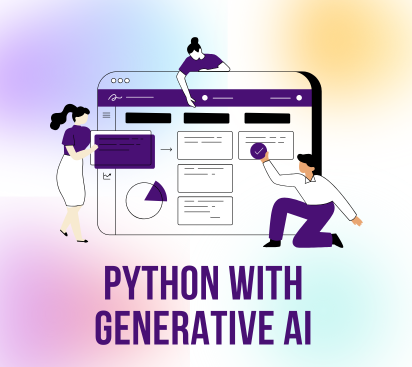

Short Overview
Python, a powerful and flexible programming language, excels in building applications, automating workflows, and analyzing data. Integrated with generative AI, Python empowers developers to craft intelligent models, create dynamic content, and revolutionize industries with cutting-edge innovations and automation.
- Necessity of Programming.
- What is Python?
- Why And Who Created It?
- What Python Can Do ?
- Why Should I learn Python?
- Important Features
- Version History
- Different Python Implementations.
- Downloading And Installing Python.
- Testing Python Installation.
- What is Python Shell?
- Using Python Shell.
- What Python Can Do ?
- Writing Python Script Using Notepad.
- Running Python Script.
- How To View The Bytecode File?
- Introduction To Predefined Functions And Mudules.
- How print() function work?
- How To Remove Newline From print()?
- Introduction To IDLE.
- Types Of Errors In Python.
- Rules For Identifiers.
- Python Reserved Words
- Basic Data Types In Python
- Some Very Important Points To Remember.
- Numeric Types.
- Converting Between Int Types.
- The Float Type.
- The Complex Type.
- The bool Type.
- The str Type.
- Concatenating Strings.
- The Slice Operator In Strings.
- Three Important String Function.
- Type conversion.
- How Variables In Python Are Different than Other Languages?
- Immutable And Mutable.
- Python's Memory Mangement.
- The id() and is() Function.
- How to write Comments in Python?
- How to create constants in Python?
- How to Print a variables value using print()?
- Types of Operators.
- Arithmetic operators.
- Special point about + and *
- Difference between / and //
- Relational Operators.
- Relational Operators With Strings.
- Chaining of Relational Operators.
- Special Behavior Of == and !=
- Logical Operators.
- How Logical Operators Work With Boolean Types?
- How Logical Operators Work With Non-Boolean Types?
- Assignment Operators.
- Various Types of Assignment Operators.
- Compound Operators.
- Identity Operators.
- Membership Operators.
- Precedence And Associativity.
- Using the Input() Function.
- Using the math Module.
- Different ways of importing a module
- Accepting multiple values in single-line.
- Using the eval() Function
- Using Command-line Arguments.
- Using format specifiers.
- Using the function format().
- The if Statement.
- Concept of Indentation.
- The if-else Statement.
- The if-elif-else Statement.
- What about ternary operator?
- Types of loop supported by Python.
- The while loop.
- The while-else loop.
- The break,continue and pass Statement.
- The for loopIntroduction to Pycharm
- Introduction to Pycharm IDE
- Downloading and Installing
- Developing Fist Application In Pycharm.
- What is a Function?
- Function v/s Method.
- Steps Required For Developing user Defined Function.
- Calling a Function
- Returning value form Function
- Arguments v/s Parameters
- Types Of Arguments
- Variable Scope.
- Global Scope.
- Variable Scope.
- Argument Passing.
- Anonymous Functions or Lambda Function
- The map() Function
- The filter () Function
- Using map() and filter() Lambda Expressions.
- What is a List?
- Creating a List.
- Accessing The List Elements
- Adding new Data In the List
- The Slice Operator With List
- Modifying A List
- Deletion In A List
- Appending / Prepending Item In a List
- Multiplying A List
- Membership Operators On List
- Built In Functions For List
- Method Of List
- List Comprehension
- What Is A Tuple?
- Differences With List
- Benefits Of Tuple
- Creating Tuple
- Packing / Unpacking A Tuple
- Accessing A Tuple
- Changing the Tuple
- Deleting the Tuple
- Functions Used With Tuple
- Method Used With Tuple
- Operations Allowed On Tuple
- What is A String?
- Creating A String
- Different Ways Of Accessing Strings
- Operators Which Work On Strings
- Built In String Functions
- Printing String using f-string
- Modifying Strings
- String Methods
- What is A Dictionary?
- What is key- value pair?
- Creating A Dictionary
- Important Characteristics Of A Dictionary
- Different Ways To Access A Dictionary
- Updating Elements In Dictionary
- Removing Elements From Dictionary
- Functions Used In Dictionary
- Dictionary Methods
- Dictionary Comprehension
- Restrictions On Keys
- Introduction To Exception handling
- Exception Handling Keywords
- Exception Handling Syntax
- Handling Multiple Exceptions
- Handling All Exceptions
- Using Exception Object
- Getting Details Of Exception
- Raising An Exception
- Using finally Block
- Creating user Defined Exceptions
- What is Operator Overloading
- How To Perform Operator Overloading
- List of Operator Which Can Be Overloaded
- Reverse Arithmetic Operators
- What is Data And Database?
- What is DBMS?
- What is SQL?
- How to configure our system for database programming.
- Introduction To SQLite
- Using Exception Object
- Steps Needed For Connecting To SQLite From Python
- Exploring Connection And Cursor Objects
- Executing the SQL Queries
- Different Ways of Fetching the Data
- Executing INSERT Command
- Executing Dynamic Queries
- Concept of Bind Variables
- Executing Update Command
- Executing Delete Command
- What is File Handling?
- What is the need of File Handling?
- Examples Where Files Are Used?
- Python's Way of handling Files
- Files Opening Modes
- Writing In A File
- Different Ways For Reading From File
- The seek() Method
- Appending in a File
- Using with statement
- What is module?
- Different ways of Importing Module
- The concept of the variable__name__
- Introduction To AI
- Natural Intelligence V/s Artificial Intelligence
- How AI Is Impacting Our Lives ?
- The AI Tech Stack
- Working with API and JSON
- Introduction To NLP
- Machine Learning For NLP
- Deep Learning For NLP
- Project-Sentiment Analysis
- Project-Categorization Of Fake News
- LSTM(Long Short Term Memory) And RNN(Recurrent Neural Network)
- LSTM And GRU End To End Deep Leaning Project- Predicting The Next Word
- Transformer Architecture
- Introduction To Generative AI and LLM Models
- LangChain And Open AI
- Building Basic LLM Applications Using LCEL
- Project-Chat With SQLDB Using LangChain
- Understanding RAG
- Vector Databases
Basic to Advance
- Basic to Advance : Learn Python programming from basics to advanced concepts.
- Zero to Hero : Transform yourself from a beginner to an advanced coder.
- Data Types to Data Base : Cover a wide range of Python programming concepts, from data types to databases.
Live Lectures
- 80+ Hours : Attend live lectures and learn from the comfort of your home.
- Hands-on Practice : Get hands-on experience by practicing coding exercises during the lecture.
- Practice Session : Get dedicated practice sessions to revise and reinforce your learning.
Doubt Solving
- Unlimited Doubts Clearing Facility : Clear all your doubts with our dedicated faculty.
Test Series and Assignments
- Dedicated Test Series after Every Topic : Test your knowledge and progress with dedicated test series.
- Assignments : Practice coding exercises to reinforce your learning.
Notes of Every Lecture
- Dedicated Notes for Every Lecture : Get access to notes for every lecture.
Projects
- Live Projects to Practice Python Programming Concepts : Get hands-on experience by working on live projects.
- OOPs Concepts in Project : Learn how to apply Object-Oriented Programming (OOP) concepts in a practical setting.
- Best Industry Practices: Learn how to apply best industry practices to build the project.
Certifications
- Two Certificates After Completion of Project : Get two certificates after completing the Python programming course and the project.
- Python Completion Certificate : Get a certificate of completion for Python programming.
- Project Completion Certificate : Get a certificate of completion for the project.
Laptop / Computer Spefiications
- System With Minimum I3 Processor Or Better
- At Least 4 Gb Of Ram
Python Interpreter
Integrated Development Environment (IDE) or Text Editors
- Download PyCharm
- Download Visual Studio Code
- Install Jupyter via Anaconda
- Download Sublime Text
- Download Atom
Package Management
Version Control
Databases
Libraries and Frameworks
- NumPy Documentation
- Pandas Installation
- Matplotlib Installation
- Django Installation
- Flask Installation
- Requests Installation
- BeautifulSoup4 Installation
- Scrapy Installation
- Pytest Installation
Optional Tools
Documentation Tools
Ready to kick-start your career?
Join Us Now Join Us Now



